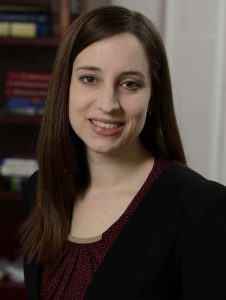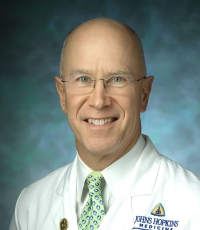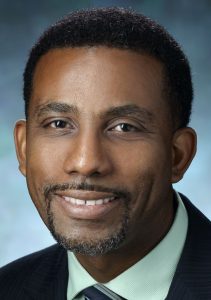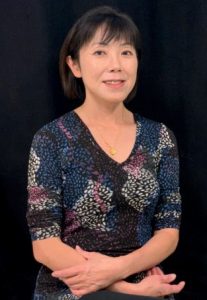Four Johns Hopkins professors are the inaugural recipients of grants for their research through the Bisciotti Foundation Translational Fund.
Established with a generous multiyear gift from the Stephen and Renee Bisciotti Foundation, the fund provides $300,000 annually in seed money to advance Johns Hopkins discoveries on a commercial path. Recipients are awarded between $25,000 and $100,000 to conduct their work over a period of up to nine months.
For the inaugural funding round, 17 applications were submitted. Finalists presented their work in February to an outside panel of scientists, researchers and investors.
All of the applicants have made a report of invention to Johns Hopkins Technology Ventures.
“We were pleased with the diverse set of technologies represented among the applicants and awardees, from solar cells to surgical tools to cancer therapies,” says Nina Urban, associate director of FastForward, JHTV’s startup program. “This represents the breadth and depth of Hopkins innovation.”
The annual application deadline for the Bisciotti Translational Fund is Oct. 15. The deadline for applications for another translational fund, the Louis B. Thalheimer Fund for Translational Research, is March 15.

Susanna Thon
Diffuse-Light-Collecting Microconcentrators for High Efficiency Solar Cells
Principal investigator: Susanna Thon, assistant professor of electrical and computer engineering
The pitch: Making solar energy cheaper and more widely deployable with the next generation of solar cells.
There are two main ways to increase the power output of solar cells: Create new materials with excellent solar-cell properties or improve the device’s architecture to increase efficiency. Silicon-based solar cells now dominate the market, but they are energy-intensive to produce, and they require large amounts of material. Thon and her colleagues at the Whiting School of Engineering have developed and tested concentrators to maximize light absorption in third-generation solar cells in a cost-effective way. The technology dramatically increases power output by creating lenses that can be bonded directly to solar cells and deliver up to 20 times the current of existing third-generation technologies. The compact design allows the solar-cell-concentrator systems to be placed on any surface to collect diffuse light without tracking the sun, unlike traditional concentrator technology. Johns Hopkins Technology Ventures is pursuing patent protection for the technology.
Mitigation of Implant Migration Risk in a Preclinical Model for Endoscopic Urethral Reconstruction

Edward James Wright III
Principal investigator: Edward James Wright III, director, Division of Neurological and Reconstructive and Neurological Urology, and chief of urology at Johns Hopkins Bayview Medical Center
The pitch: A disposable medical device to repair a urethral stricture without invasive surgery.
More than $300 million is spent annually treating urethral strictures — scar tissue that narrows the urethra, resulting in restricted, painful and frequent urination. Current treatment options include urethrotomy, an internal incision to widen the stricture. This procedure is minimally invasive but marginally effective, and when repeated can worsen the scarring. Another current option is urethroplasty, an effective but invasive and complex reconstructive procedure that urologists rarely perform. Wright and a team of engineers created a disposable graft carrier and retrieval device that enters the urethra through its natural orifice, then expands to a precise size at the target site and adheres to the urethra. The device is retrieved seven to 10 days later, leaving the now integrated graft behind and resulting in a widened urethral caliber and improved flow. The procedure is done endoscopically and can be performed by a general urologist. JHTV is pursuing patent protection for the technology.
Structural and Mechanical Assessments of BiO2-Bone Scaffolds for Regenerating Craniofacial Bone

Warren Grayson
Principal investigator: Warren Grayson, associate professor, Department of Biomedical Engineering
The pitch: A novel way to repair large facial bone loss from cancer or congenital disorders.
The most reliable treatment of large bone defects in the face is to transplant bone from another part of the patient’s body. But the procedure is costly, can take more than 12 hours and often requires multiple revision surgeries. Grayson, who oversees a lab devoted to craniofacial and orthopaedic tissue engineering, wants to use the patient’s stem cells combined with scaffolds to regenerate bone tissue. The scaffolds are 3D-printed and contain oxygen-delivering “microtanks” that help the stem cells survive, proliferate, regenerate bone mineral tissue and form vascular networks. Grayson is setting up a company through JHTV’s FastForward program, and JHTV is pursuing patent protection related to the technology.

Tian-Li Wang
Development of Small Molecule Compounds Targeting PBX1/DNA Transcriptional Complex
Principal investigator: Tian-Li Wang, professor of pathology, oncology and gynecology/obstetrics
The pitch: A novel molecule that can treat chemotherapy-resistant ovarian cancer.
Approximately 22,000 women receive a new diagnosis of ovarian cancer each year, with an average five-year survival rate of 50 percent. While ovarian cancer is initially responsive to surgery and chemotherapy, more than 70 percent of patients experience a recurrence. Wang and colleagues have discovered a compound that targets a protein found at significantly high levels in recurrent ovarian cancer cases. Should the compound prove effective at inhibiting ovarian cancer, a future drug could be used to treat other recurrent diseases, including breast cancer. Wang’s team recently formed a company through FastForward and is considering licensing the technology. JHTV is pursuing patent protection for the technology.